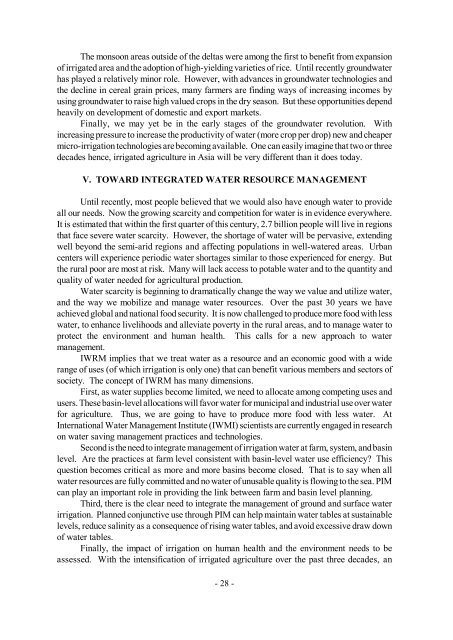Organizational Change for Participatory Irrigation Management
Organizational Change for Participatory Irrigation Management
Organizational Change for Participatory Irrigation Management
You also want an ePaper? Increase the reach of your titles
YUMPU automatically turns print PDFs into web optimized ePapers that Google loves.
The monsoon areas outside of the deltas were among the first to benefit from expansion<br />
of irrigated area and the adoption of high-yielding varieties of rice. Until recently groundwater<br />
has played a relatively minor role. However, with advances in groundwater technologies and<br />
the decline in cereal grain prices, many farmers are finding ways of increasing incomes by<br />
using groundwater to raise high valued crops in the dry season. But these opportunities depend<br />
heavily on development of domestic and export markets.<br />
Finally, we may yet be in the early stages of the groundwater revolution. With<br />
increasing pressure to increase the productivity of water (more crop per drop) new and cheaper<br />
micro-irrigation technologies are becoming available. One can easily imagine that two or three<br />
decades hence, irrigated agriculture in Asia will be very different than it does today.<br />
V. TOWARD INTEGRATED WATER RESOURCE MANAGEMENT<br />
Until recently, most people believed that we would also have enough water to provide<br />
all our needs. Now the growing scarcity and competition <strong>for</strong> water is in evidence everywhere.<br />
It is estimated that within the first quarter of this century, 2.7 billion people will live in regions<br />
that face severe water scarcity. However, the shortage of water will be pervasive, extending<br />
well beyond the semi-arid regions and affecting populations in well-watered areas. Urban<br />
centers will experience periodic water shortages similar to those experienced <strong>for</strong> energy. But<br />
the rural poor are most at risk. Many will lack access to potable water and to the quantity and<br />
quality of water needed <strong>for</strong> agricultural production.<br />
Water scarcity is beginning to dramatically change the way we value and utilize water,<br />
and the way we mobilize and manage water resources. Over the past 30 years we have<br />
achieved global and national food security. It is now challenged to produce more food with less<br />
water, to enhance livelihoods and alleviate poverty in the rural areas, and to manage water to<br />
protect the environment and human health. This calls <strong>for</strong> a new approach to water<br />
management.<br />
IWRM implies that we treat water as a resource and an economic good with a wide<br />
range of uses (of which irrigation is only one) that can benefit various members and sectors of<br />
society. The concept of IWRM has many dimensions.<br />
First, as water supplies become limited, we need to allocate among competing uses and<br />
users. These basin-level allocations will favor water <strong>for</strong> municipal and industrial use over water<br />
<strong>for</strong> agriculture. Thus, we are going to have to produce more food with less water. At<br />
International Water <strong>Management</strong> Institute (IWMI) scientists are currently engaged in research<br />
on water saving management practices and technologies.<br />
Second is the need to integrate management of irrigation water at farm, system, and basin<br />
level. Are the practices at farm level consistent with basin-level water use efficiency? This<br />
question becomes critical as more and more basins become closed. That is to say when all<br />
water resources are fully committed and no water of unusable quality is flowing to the sea. PIM<br />
can play an important role in providing the link between farm and basin level planning.<br />
Third, there is the clear need to integrate the management of ground and surface water<br />
irrigation. Planned conjunctive use through PIM can help maintain water tables at sustainable<br />
levels, reduce salinity as a consequence of rising water tables, and avoid excessive draw down<br />
of water tables.<br />
Finally, the impact of irrigation on human health and the environment needs to be<br />
assessed. With the intensification of irrigated agriculture over the past three decades, an<br />
- 28 -
















